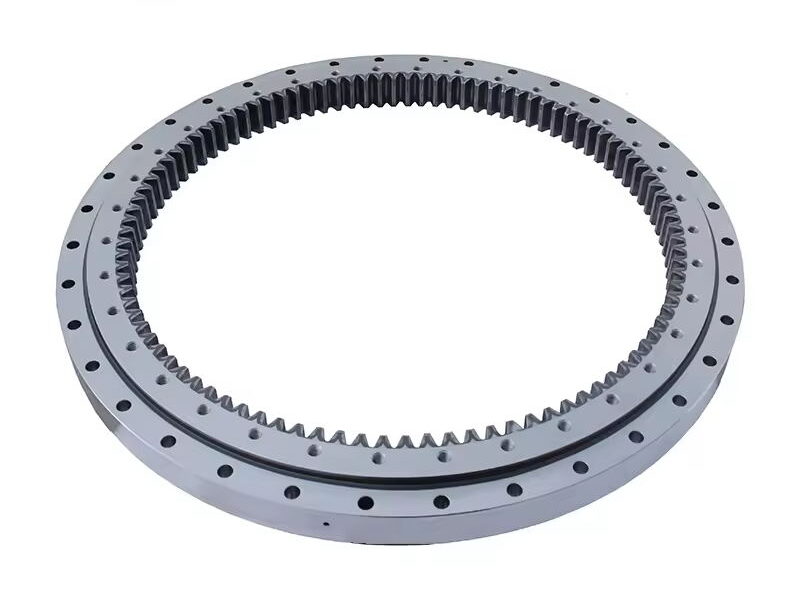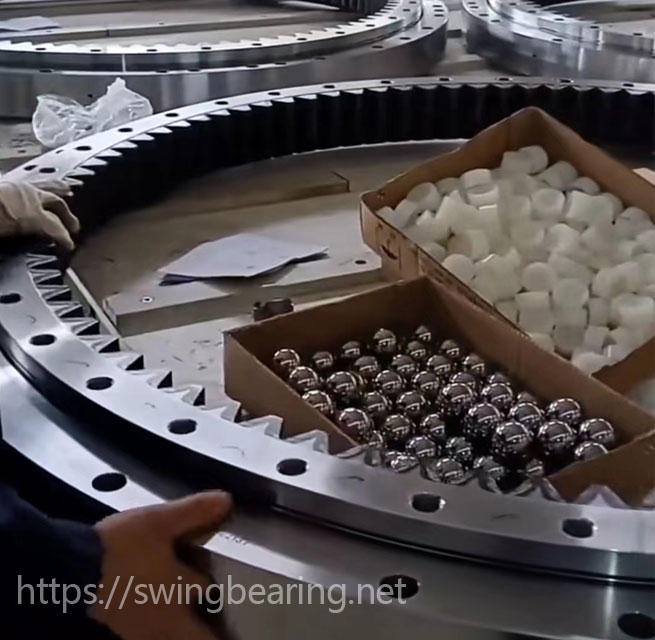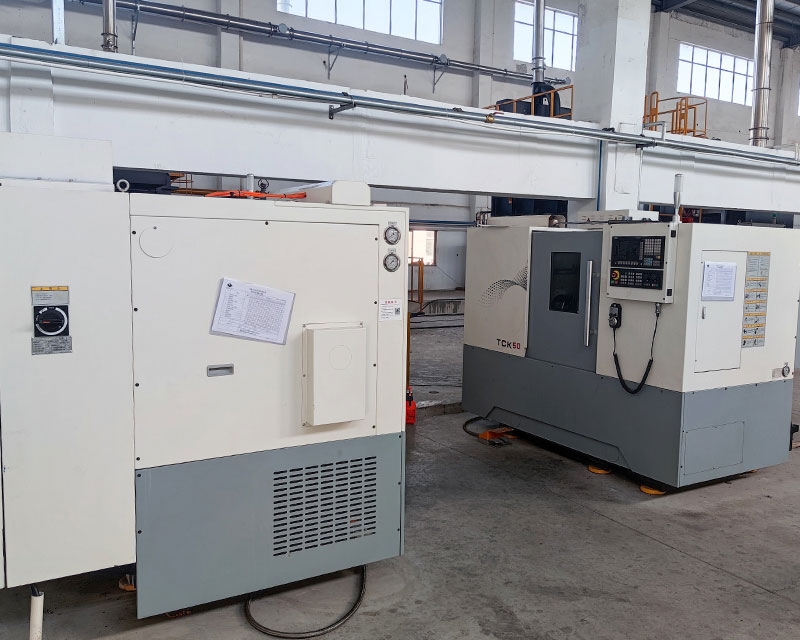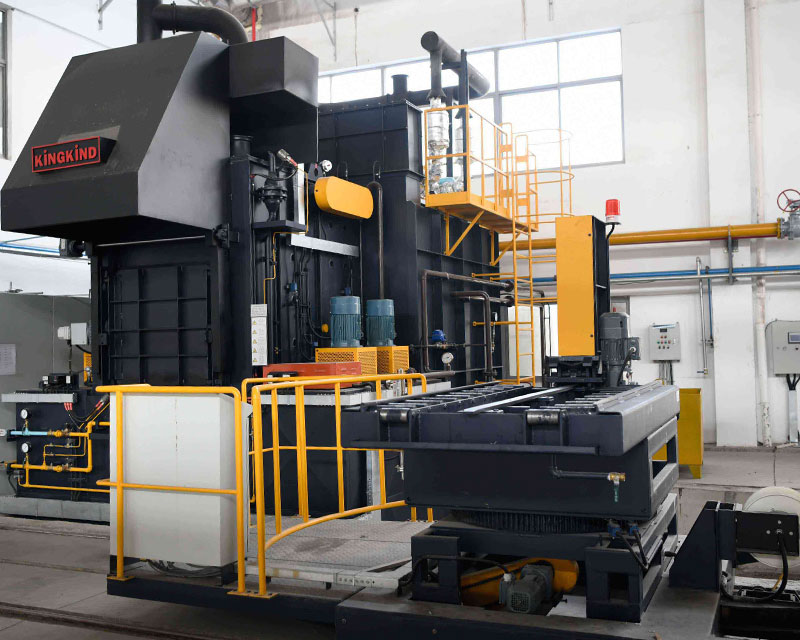
In the world of heavy machinery, ekskavaatorite pöördlaagrid are crucial components that enable smooth and efficient rotational movements of the equipment. During their manufacturing process, burrs or spikes can often form on the surfaces of these bearings. These imperfections, although small, can significantly affect the performance, installation, and lifespan of the bearings. Burrs can cause issues such as poor operation, thermal blocking, oil leakage, and even damage to other components. Therefore, it is essential to effectively remove these burrs to ensure the optimal functionality of the excavator slewing bearings. This comprehensive guide delves into various methods for burr removal, including electromagnetic, high-temperature, chemical, and flip grinding techniques. Each method is explained in detail, highlighting its suitability, advantages, and operational considerations.

The electromagnetic method, also known as electrolysis, utilizes electromagnetic energy to chemically melt and remove burrs from metal surfaces. This process involves the anodic oxidation of the burrs, which are then dissolved through an electrochemical reaction. The slewing bearing is connected to the positive terminal of a power supply, while a dedicated tool connected to the negative terminal facilitates the current flow. When an alternating current (AC) is applied, electrochemical corrosion occurs, leading to surface melting and burr removal.
The electromagnetic method requires a numerically controlled lathe equipped for electrolytic deburring. Custom fixtures are designed based on the specific structure of the slewing bearing. Typically, conductive materials such as copper or brass are used for the fixtures, with epoxy resin applied to insulate areas that do not require deburring.
This method is particularly effective for removing burrs from complex parts, including transverse holes and internal surfaces. It can handle hard materials such as molybdenum, nickel, titanium, and components subjected to heat treatment. The versatility and precision of the electromagnetic method make it suitable for a wide range of applications, ensuring that even the most intricate burrs are effectively removed.

The primary advantage of the electromagnetic method is its precision and ability to handle complex geometries and hard-to-reach areas. It provides a high level of control over the deburring process, ensuring minimal impact on the surrounding material. Additionally, this method can be tailored to different materials by adjusting the electrolyte composition and process parameters.
However, the electromagnetic method requires specialized equipment and expertise, which can increase the initial setup cost. It also necessitates careful handling of the electrolytes and maintenance of the equipment to ensure consistent performance.
The high-temperature method involves using a mixture of combustible gases to generate intense heat, which burns off the burrs on the slewing bearing surfaces. This method is suitable for all metal materials, as well as plastic and rubber parts. The high temperature causes the burrs to oxidize and vaporize, leaving a clean and smooth surface.
The process begins by preparing a gas mixture, typically involving methyl substances, which is ignited to produce a sustained high-temperature flame. The slewing bearing parts are cleaned and dried before being exposed to this flame. The heat causes the burrs to burn off without affecting the integrity of the main component.
Adjusting the gas pressure and mixture ratio is crucial for different materials. For instance, steel and carbon steel require higher gas pressure, whereas brass and aluminum alloys necessitate lower pressures. To prevent oxidation of the main component, the parts are often pre-treated in a calcium phosphate solution.
The high-temperature method is highly effective for rapid and thorough burr removal. It can handle a wide variety of materials and shapes, making it versatile for different types of slewing bearings. Additionally, it ensures that the main component remains unaffected by the heat, preserving its structural integrity.
However, this method requires careful control of the gas mixture and flame to avoid damaging the main component. It also involves handling combustible gases, which necessitates stringent safety measures and proper ventilation in the working area.
The chemical method involves immersing the excavator slewing bearing parts in a chemical solution that selectively dissolves the burrs through a controlled reaction. This method is suitable for various metal materials and can be tailored by selecting appropriate chemicals for different types of metals.

The parts to be deburred are submerged in a chemical bath containing a solution tailored to the specific metal composition of the parts. Common chemicals used include sulfuric acid, hydrochloric acid, potassium thiocyanate, and calcium phosphate. The chemical reaction converts the burrs into a soluble form, which then dissolves in the solution.
The process parameters, such as concentration, temperature, and immersion time, are carefully controlled to ensure effective burr removal without affecting the main component. After the burrs are dissolved, the parts are thoroughly rinsed to remove any residual chemicals.
The chemical method is highly effective for removing fine burrs and is particularly useful for parts with complex geometries or internal surfaces. It provides a uniform and consistent finish, enhancing the overall quality of the component.
However, the method involves handling hazardous chemicals, which requires proper safety measures and disposal procedures. Additionally, it may not be suitable for materials that are sensitive to chemical reactions or require precise control over the surface finish.
The flip grinding method, also known as tumbling or barrel finishing, involves placing the slewing bearing parts in a closed container along with abrasive media. The container is then rotated, causing the parts and media to tumble and grind against each other, effectively removing burrs and smoothing the surfaces.
The parts to be deburred are placed in a tumbling barrel along with abrasive media such as quartz sand, aluminum oxide, ceramics, or other wear-resistant materials. The barrel is then rotated at a controlled speed, causing the parts and media to collide and grind against each other.
The selection of abrasive media and process parameters, such as rotation speed and duration, is tailored to the specific material and burr characteristics. The tumbling action gradually wears down the burrs, resulting in smooth and polished surfaces.
The flip grinding method is cost-effective and suitable for small to medium-sized parts. It can handle a variety of materials and provides a consistent finish across multiple parts simultaneously. The method is also relatively simple to implement and requires minimal specialized equipment.
However, it may not be suitable for removing large burrs or for parts with highly intricate geometries. The abrasive media can also cause wear on the main component if not carefully controlled, making it important to optimize the process parameters for each application.
Effective burr removal is essential for ensuring the optimal performance and longevity of excavator slewing bearings. Each of the methods discussed—electromagnetic, high-temperature, chemical, and flip grinding—offers unique advantages and is suited to specific applications and material types. By understanding the principles, processes, and considerations of each method, manufacturers can select the most appropriate technique for their specific needs. Regular maintenance and proper handling of the slewing bearings during manufacturing and installation further enhance their performance and durability, reducing the risk of operational issues and extending the service life of the equipment.
Q1: Why is it important to remove burrs from excavator slewing bearings?
A1: Burrs on excavator slewing bearings can affect the installation, performance, and lifespan of the bearings. They can cause poor operation, thermal blocking, oil leakage, and damage to other components, leading to operational inefficiencies and potential equipment failure.
Q2: What are the advantages of the electromagnetic method for burr removal?
A2: The electromagnetic method offers precision and can handle complex geometries and hard-to-reach areas. It provides high control over the deburring process, ensuring minimal impact on the surrounding material and is suitable for hard materials such as molybdenum, nickel, titanium, and components subjected to heat treatment.
Q3: How does the high-temperature method remove burrs from slewing bearings?
A3: The high-temperature method uses a mixture of combustible gases to generate intense heat, which burns off the burrs on the slewing bearing surfaces. The high temperature causes the burrs to oxidize and vaporize, leaving a clean and smooth surface. This method is suitable for all metal materials, plastic, and rubber parts.
Q4: What safety considerations are necessary for the chemical method of burr removal?
A4: The chemical method involves handling hazardous chemicals, which requires proper safety measures such as protective gear, ventilation, and safe disposal procedures for the used chemicals. It is essential to control the concentration, temperature, and immersion time of the chemical solution to ensure effective burr removal without damaging the main component.
Q5: When is the flip grinding method most suitable for burr removal?
A5: The flip grinding method is most suitable for small to medium-sized parts and can handle a variety of materials. It is cost-effective, provides a consistent finish, and is relatively simple to implement. However, it may not be suitable for removing large burrs or for parts with highly intricate geometries.